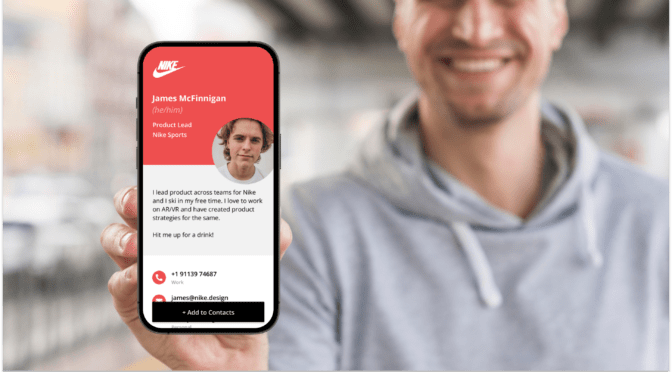They say you never get a second chance to make a first impression. And “they” are right. People instinctively judge you based on body language and facial expressions within seconds.
Rooted in evolutionary psychology, this snap judgment might have helped our ancestors avoid threats, but today, it shapes every interaction—from careers to relationships—and its consequences.
So, how do you make a good first impression? Is there something beyond a firm handshake or a confident smile? How do you create an authentic presence that resonates long after meeting? Let’s explore the science and strategies behind making a lasting impact.
Table of contents
- What is a first impression and why is it important?
- The science of first impressions: Why they happen fast and why they last
- How to make a great first impression?
- Elevate your networking game with Uniqode’s virtual business cards
- Frequently asked questions
What is a first impression, and why is it important?
Imagine walking into a room full of strangers. Before introducing yourself, people have already sized you up, noticing your posture, hand swing, shoes, eye contact, and more. That’s a first impression—the instant judgment people make about you, often without realizing it.
Why is creating a good first impression important? Because it sets the tone for all future interactions. A positive first impression can open doors to opportunities, build trust, and foster strong relationships.
The science of first impressions: Why they happen fast and why they last
Ever heard of the seven-second rule? Studies suggest that people form first impressions within seven seconds or even faster.
According to research on communication psychology, only 7% of a first impression is based on what you say. In comparison, 38% comes from your tone of voice, and a whopping 55% is influenced by body language. A confident stance, warm smile, and steady eye can go a long way.
Once a first impression is formed, it tends to stick, thanks to a psychological phenomenon called the Primacy Effect. It means that the information we learn first has a lasting impact on how we perceive someone.
💡Example: Steve Jobs’ minimalist wardrobe is a good inspiration for the Primacy Effect working in a person’s favor. His signature black turtleneck, jeans, and sneakers created a powerful first impression of simplicity, innovation, and consistency. Over time, this look became synonymous with Apple’s sleek, minimalist branding. Can you think of other tech moguls dressing up similarly?
Now, the question is: how do you make a great first impression?
How to make a great first impression?

Making a great first impression isn’t just about looking confident; it’s also about how you present yourself and communicate.
In-person first impressions set the stage, as everything from your posture to eye contact and attire influences how others perceive you.
Verbal and conversational strategies shape the interaction, ensuring you come across as engaging, articulate, and approachable.
But first impressions don’t end when the conversation does—follow-up impressions solidify relationships, helping you stay memorable and build trust over time.
Let’s break down these critical areas to ensure your first impression is unforgettable.
In-person first impressions
In-person first impressions set the tone for future interactions. A confident posture, warm smile, and firm handshake typically create a sense of trust and approachability and ultimately lead to a good first impression.
1. The right body language

Open postures vs. closed postures: Open postures (arms uncrossed, standing tall) signal confidence and approachability, while closed postures (arms crossed, slouching) can make you seem defensive or uninterested.
- Body-language experts suggest keeping your shoulders back, chin up, and arms relaxed to appear more welcoming.
The triple nod technique: This simple trick involves nodding three times when someone speaks, reinforcing your engagement and interest.
- Try using this technique in conversations. It subtly encourages the other person to continue speaking and feel valued.
💜Learn from the best: Oprah Winfrey is a master at body language. She masterfully leans in, maintains eye contact, and mirrors her guests’ expressions to create an instant connection.

2. The perfect handshake (or its alternative in a post-pandemic world)
The psychology behind it: A firm handshake conveys confidence and credibility, while a weak one can make you seem unsure.
- Aim for a grip that’s firm but not crushing, with two to three shakes. Presidents and heads of state are some of the best people you can look up to to learn a handshake.
Cultural differences: When a handshake might not be appropriate, you may replace it with bows, nods, or hand-on-heart gestures.
- Research cultural norms before meeting international clients or colleagues.
What are the alternatives? If handshakes aren’t an option, a well-timed nod, friendly wave, or slight bow can still make a great impression.
- Choose a greeting style that aligns with the situation while maintaining warmth and confidence.
3. Dressing for impact
Dress appropriately: When in doubt, opt for more formal attire than expected.
Stand out (tastefully): A unique accessory or signature style can make you instantly recognizable.
- Find a balance between fitting in and standing out, a bold tie, an elegant brooch, or a distinct color scheme.
💜Learn from the best: What works best? Facebook founder Mark Zuckerberg’s hoodie or a CEO’s power suit? While Zuckerberg’s casual style aligns with Silicon Valley’s culture, traditional CEOs often rely on suits to exude authority. So, remember that you should dress to match the expectations of your industry while staying true to your brand.

Verbal and conversational strategies
Speaking clearly and confidently helps convey credibility and self-assurance. Let’s explore some strategies.
1. The icebreaker
Avoid clichés: Keep a few unique icebreakers in your back pocket to spark engaging discussions.
- Instead of the predictable “What do you do?” try “What’s something exciting you’re working on?” or “What’s the best part of your day so far?”
Use situational compliments: A genuine compliment based on the situation can create an instant connection.
- Instead of generic compliments, say, “That’s a great choice of color on your jacket. It stands out!”
💜Learn from the best: Barack Obama at it again! Mr. Ex-President is known for making people feel special by being present, using humor, and showing genuine curiosity. You can draw inspiration from him, make eye contact, use open body language, and ask follow-up questions to keep the conversation flowing.
2. The elevator pitch 2.0
Introduce yourself memorably and concisely: A good elevator pitch should quickly explain who you are, what you do, and why it matters.
- Stick to 30 seconds or less and make it conversational rather than robotic. Here’s a strong elevator pitch template that you can adapt to your needs:
“Hi, I’m [name], a [your role] at [company/industry]. I specialize in [what you do] to help [target audience] solve [key problem] through [your unique solution]. Recently, I [notable achievement or interesting fact]. I’d love to connect—here’s my digital business card so we can stay in touch!”
3. Active listening
The FBI’s mirroring technique: Mirroring involves subtly repeating keywords or phrases the other person says to build rapport.
- If someone says, “I love hiking,” respond with, “Oh, you love hiking? What’s your favorite trail?” Here, you show active listening and genuine interest by repeating, “Oh, you love hiking?” before asking a follow-up question. This makes the other person feel understood and encourages them to share more, making your first impression more positive and memorable.
The 2:1 rule: Speak less, listen more. Aim to listen twice as much as you talk to create meaningful connections.
- Ask open-ended questions and let the other person share more about themselves.
Repeat key phrases: Repeating key points shows that you’re engaged and value what’s being said.
- If someone mentions a significant achievement, acknowledge it by repeating and emphasizing its importance, “Wow, leading that project sounds like a huge responsibility!”
Follow-up impressions for long-term impact
Following up after an initial meeting is essential for reinforcing a good first impression and building long-term relationships. Let’s discuss this further.
1. Follow-ups that leave a lasting impression
The 24-hour rule: The 24-hour rule suggests following up within a day to reinforce the connection while the conversation remains fresh in the other person’s mind:
- Send a quick follow-up within 24 hours of meeting someone
- Mention a specific detail from your conversation to show you were engaged
- Keep it concise and professional but warm
💡Example: Instead of just saying, “Great meeting you!” try:”Hi [name], I enjoyed our chat about [specific topic] at [event/meeting]. Your insights on [key takeaway] were eye-opening! I’d love to continue the conversation. Let’s connect over coffee next week.”
🔥If you use Uniqode: You can capture contact information with your digital business cards and sync straight to your CRM (such as Salesforce!). From there, fire off personalized follow-ups—turning chance encounters into lasting connections.

-
Uniqode integrates with other CRMs, such as HubSpot, Pipedrive, Insightly, etc., natively or through Zapier to easily export and manage your contacts.
A personalized email vs. a generic LinkedIn message: Following up with a well-crafted email can make you stand out, while a generic LinkedIn message can easily be ignored:
- Keep the email short, warm, and personalized. Before asking for anything, mention how you can add value
- On LinkedIn, avoid generic “Let’s connect!” messages. Instead, mention where you met and why you’re reaching out
💡Example:
❌ Generic LinkedIn Message: “Hi, let’s connect!”
✅ Personalized LinkedIn Message: “Hi [name], I enjoyed our conversation about [topic] at [event]. Your take on [specific insight] was fascinating! Let’s connect. I’d love to stay in touch.”
2. Adding value before asking for anything
The give-first strategy: People are more likely to help you if you offer value first. This is the principle of reciprocity. Instead of immediately asking for favors, give before you take:
- Share valuable resources (e-books, guides, templates)
- Introduce them to relevant contacts in your network
- Offer insights or feedback on something they’re working on
3. Staying memorable in a crowded network
The “Remember Me” strategy: With so many people networking, how do you stand out? Having a memorable hook, a unique detail, or a catchphrase makes it easier for people to recall you:
- Tie your introduction to a fun fact or distinctive detail
- Use storytelling instead of just stating your job title
- Reference a shared experience or interest to create a connection
💡Example: Instead of saying, “I’m a financial consultant,” try: “I help people stop losing sleep over their finances—think of me as your financial therapist!”
Follow up with relevant materials: Instead of just saying, “Great meeting you!” stay on their radar by sending helpful content that aligns with their interests. It could be articles, podcasts, or event invites:
- If they mentioned an interest in AI, send them a great podcast episode about it
- Invite them to a networking event if they’re working on a startup
Elevate your networking game with Uniqode’s virtual business cards
Mastering the art of first impressions isn’t about playing a character; it’s about showcasing your best, most authentic self.
Try these practical strategies to navigate social or professional settings and build stronger connections.
And to give your networking efforts the little boost they need, try Uniqode’s digital business cards!
Frequently asked questions
1. What are the most important things to remember when making a first impression?
Here are some things to remember while making a good first impression:
- Body language: This includes posture, eye contact, facial expressions, and hand gestures.
- Verbal communication: Encompasses your tone of voice, the words you choose, and how clearly you articulate yourself.
- Appearance: Dressing appropriately for the occasion and maintaining a neat and professional appearance is crucial.
2. How long does it take to form a first impression?
Research suggests that people form first impressions within seconds – some studies say as little as seven seconds. This highlights the importance of making a strong impression right from the start.
3. How can I overcome a bad first impression?
- Be aware of your mistakes: Reflect on what might have gone wrong and take responsibility for your part.
- Make a conscious effort to change perceptions: Demonstrate positive qualities like competence, trustworthiness, and warmth in subsequent interactions.
- Be patient: Changing a negative perception takes time and consistent effort.
4. What are some common mistakes people make when making a good first impression?
- Being inauthentic: Trying too hard to impress or pretending to be someone you’re not can backfire.
- Focusing too much on themselves: Dominating the conversation or not showing interest in the other person can be off-putting.
- Neglecting body language: Poor posture, lack of eye contact, or fidgeting can convey nervousness or disinterest.
- Failing to follow up: Not reinforcing the connection after the initial meeting can fade the first impression.
- Being unprepared: Not knowing enough about the person or the situation can lead to awkwardness or missed opportunities.
Sukanya is a Content Marketer at Uniqode and a former journalist who fuses newsroom curiosity with SEO-savvy storytelling to help brands grow online. She’s on a mission to demystify digital business cards, digging deep into data, trends, and user behavior to spotlight how they transform how we network and generate leads. Her content doesn’t just inform—it equips. Outside the digital realm, she’s either rescuing animals, getting lost in a plot twist, whipping up kitchen experiments, or chasing stories worth telling.
Related Posts
14 day free trial of the QR platform













